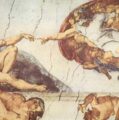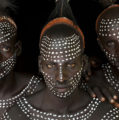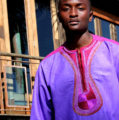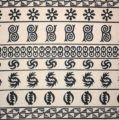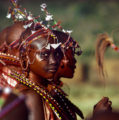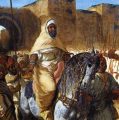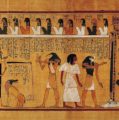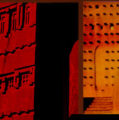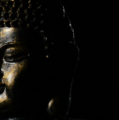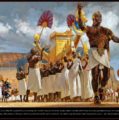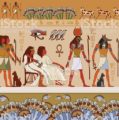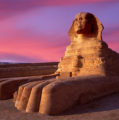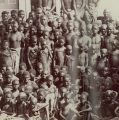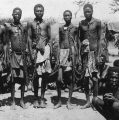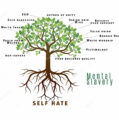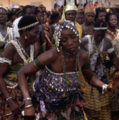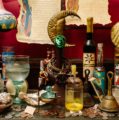

African Kingdoms
History February 17, 2017 Khaleel Muhammad

Cradle of Civilizations and Humanity
See Also | Religion in Africa | Islamic Africa | African Legends | African People
Kings Pharaohs Sultans. Call them what you will but giants once roamed the Earth. Giants with a will of caste iron and hearts as fierce as dragons. The sands of time pour backwards; the tombs of history are flung open—Africa pours out her secrets.
Paint a picture of tomorrow and you draw from the colors of the past– Khaleel Muhammad
Even as the artisan castes hues of reds and blues upon a canvas to inspire hearts with an image of beauty – he can only do so by expressing what came before him and all that he is! The tip of his brush bristles with light as rays of color fall to the blank sheet below… and a masterpiece is realized. So too is the retelling of antiquities past wonders. Empires rise and fall under the artful eye of God. Those that have made their deeds into words and carved their names into stone are remembered for posterity.
The waxing and the waning of empires fortunes leave their mark in the traces of our forgetful hearts. Look within. Search deeply. Do you not feel the stirring of something unsleeping? Silence your mind and let your soul resonate in harmony with past moments of days:of trade caravans 300 camels long: of the thrill of casting a glance upon the founding of the pyramids: as the battle cry of victory ring in your ears:
African civilization is not measured by the heights of tall buildings but by the quality of human relations– ‘Alik Shahadah
The waxing and the waning of empires fortunes leave their mark in the traces of our forgetful hearts. Look within. Search deeply. Do you not feel the stirring of something unsleeping? Silence your mind and let your soul resonate in harmony with past moments of days:of trade caravans 300 camels long: of the thrill of casting a glance upon the founding of the pyramids: as the battle cry of victory ring in your ears of your joy as you gather the harvest on the great day of celebration: as your son takes his place amongst the warriors of the village. That beacon that blazes in the stillness of your essence was lit from the fires of yesteryear. And with it – at last you realize – you can never relinquish a tie to your roots forged by God Himself. Open your self and relive the wonders – of African Kingdoms!
Africa Was First
Europeans have been firm in holding up themselves as creators of civilization: That only when people left Africa did civilization come into existence. This is done by doing exactly what the Romans did before, by defining civilization to include their traits, habits, and defining everyone else’s on the outside. Hence despite all the sophistication of some “barbarian” tribes, they were still barbaric in Rome’s eyes. Civilization defined by the conquer is suspect. But now, recent to archeology, is Affad 23. proves that civilization preexisted in Africa even before Sumer and Mesopotamia which, traditionally have been held as longstanding forebears of civilization from which all subsequent civilizations spawned from.
Affad 23, is an African archaeological site located in alluvial deposits formed by an ancient channel of the Nile in the Affad District of Southern Dongola in northern Sudan. Archaeologists from the ‘Institute of Archaeology and Ethnology’ in Poznań, unearthed the remains of a settlement provisionally estimated to be 70,000 years old. [ref]
CLAIMING THE PAST
From one point of view South Africans cannot boast about building Axum, KMT, or Timbuktu, because they, as a group, played no role in it. The only ‘race” in Ancient Egypt that built the pyramids was the Egyptians themselves. This is a valid argument, but we have to consider other things also. It is human nature to take claim of the achievements of the past. All Africans lay claim to KMT, Axum, Timbuktu, Great Zimbabwe, etc, as part of our racial contribution to the world. It actually does not matter if anyone in the Diaspora or South Africa has direct Ethiopian or Ancient Egyptian blood, because what the claim is saying, is that people of African ancestry, or people who “look like us,” have within them the capability to produce great works.
And if it was ever about direct claim, then no one can claim anything. With Greece there is no direct connection to British Empire — yet it is all still culturally/academically the history of Eurasia. All of Europe talks about a connected European history. There are homages to this pan-European history all over Europe; it is embedded in the education system. But does Newton represent the average Brit? Certainly not, then why would they stretch and claim Aristotle as part of European genius?
If we cannot stretch and claim Imhotep? At one level of argument on Only Einstein should claim E=Mc2. The majority of the people are never the great innovators of history. Yet the majority of the Romans claim the work of the few genius Romans, the accomplishments of a few Aksumites become the claim of all Ethiopians. If we want to put a fine point on it, we could counter argue that because the people of modern Ethiopia have changed since the time of the great Abyssinian empires, then most of them cannot claim that history under the modern national set-up of “Ethiopian.” So the Oromo people cannot lay claim to Lalibela. And then where do we draw the line? And there is a line, but it is blurred.
It is possible to argue that all Muslim accomplishments can be claimed by Muslims because of the ideologic
al connection, just like the recent accomplishments of Japan may be claimed by modern Japanese. In other words we are finding some sphere of commonality (political, ideological, social, etc) to show that those things allow them to make a connection. Jews do this all the time when they say Jewish inventors, or Jewish Nobel Peace Prize winners. And all connections are valid at some level. This is the way human beings forge their identities on the great works of the past, to inspire them to build anew.
Ancient Egypt: Kemet
It has been noted that the first records of people describing their land as ”Motherland” were the Ancient Egyptians however the word above literally means, ‘Land of the spirits’ meaning ‘land of the Ancestors’. It is from the work of Adolf Erman and Hermann Grapow.
Worthebuch der Aegyptishen Sprache. Band V, p. 216. The Ancients referred to Africa south of their country by names such as Ta-Kenset, literally „placenta-land‟, Khenti = „ land of beginnings‟ and Ta-iakhu = „the land of the spirits‟, that is, “where the souls of ancestors dwell ( “Nile Genesis: Continuity of Culture from the Great Lakes to the Delta” in Ivan Van Sertima).
The Badarian culture provides the earliest direct evidence of agriculture in Upper Egypt during the Predynastic Era. It flourished between 4400 and 4000 BCE,[2] and might have already existed as far back as 5000 BCE.[3] It was first identified in El-Badari, Asyut.
The ideogram indicates the context in which the word applies. An ideogram for humans would always be used to represent a word that applied to people. However Kemet can only mean Black Land since the ideogram indicates it is describing a built or non-human environment. But none of this discredits the founders of Kemet as being African people, just like the Fulani or the Amhara. “Black” in the North American context.
The “social “construction of race in America does not rely on skin color. “African Americans,” as Asante notes, ” constitute the most heterogeneous group in the United States biologically, but perhaps one of the most homogeneous socially.”
The mallet rises and falls and again the cycle of history turns. The waning of Ta-Seti gave birth to the waxing of the majestic dynasties of Ancient Egypt. The Pharaoh Narmer, also known as Aha Mena, bound together the two lands of upper and lower Egypt in his arms and founded the First Dynasty. Renown as the founder of Memphis, Narmer quickly established it as his capital and centre of administration. From Narmers time to the close of the sixth dynasty of the Old Kingdom, man-made mountains were hewn from living rock. Pyramids, were raised in the shadow of these pharaohs. An ever lasting testimony to feats of engineering yet to be surpassed or equaled.
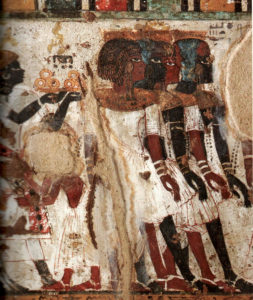
Nubian Wall art
What was to be described as the First Golden Age began in the third dynasty 5345-5043 BCE. The prodigious Pharaoh Zoser commissioned the famous architect and prime minister – Imhotep – to build him a most magnificent tomb to rival all others. Rising to the challenge Imhotep erected the step pyramid at Sakkarah that stands until this day. Unique in its construction and the model for others to follow, the step pyramid was designed to resemble a celestial stairway leading to the heavens!The pyramid text and Solar Calendar were born by the Nile river as it drew the people to it and nourished them. The length and breath of its banks resembled any metropolitan skyline with its bustling streets and markets, grave yards, government buildings and temples of worship which served a population of some 5 million inhabitants!
By the dawning of the 3rd Dynasty the world famous great pyramids were constructed under the wistful gaze of Pharaohs Khufu, Khafa and Menkaura. These monuments preceded and long outlasted other so-called wonders of the ancient world.
Over the next 11 dynasties Pharaohs rose and fell like the ebbing tide of the ocean. The close of the Old Period of Empire was signaled by the invasion of Saltis, whose subsequent defeat ushered in the new Golden Age. This time of glory witnesses the building of the Karnak Temple complex, the Abu Simbel temple in Nubia (Kush) and sea voyages of almost mythical grandeur and endeavour to the lands that would one day be called the Americas!
The twilight of the Egyptian epoch was briefly held in check by the Kushite Pharaoh, Shabaka, who re-invigorated much of the governance of the old kingdoms but by 663 BCE the Assyrians had invaded and over ran the last ruler of Egypt – Priestess Shepenwepet. Following a dramatic succession of Persia and the domination by Alexander the Great, history saw the end of the phenomena that was Egypt!
The awe-inspiring achievements of the Egyptians have given rise to a plethora of theories in an attempt to claim these wonders in the name of any one or thing – but the Africans who put forth these splendours.
Not least of these theories range from the idea that people from the Middle-East, Asians and Europeans migrated south and settled among the natives, bringing enlightenment and governance but leaving the poor backward natives to grapple with technologies and precepts beyond their impoverished tribal minds! To the far-fetched notion that visitors from beyond the stars or dwellers from inter-dimensional stargates erected the pyramids and then fled!
Such arguments, particularly the latter, are hardly worthy of a response but doubts must be addressed and the voice of reason must prevail. Although in the nineteenth century Sir Richard Burton referred to modern Egyptians as “whitewashed niggers,” and Sir Flinders Petrie referred to their ancient ancestors as being of “course mulatto stock,” neither of these formulations serve to give an agreeable pedigree to the precursors of Western civilization. One writer that deal with race is Lefkowitz (a textbook anti-African orientalist White Supremist) go to considerable lengths to prove that “Blacks,” however defined, are not part of the story. Indeed, it was for this reason that Giuseppe Sergi, an Italian anthropologist overcame the problem in the 1880s by divining that the ancient Egyptians were dark — sometimes very dark — Caucasians. He labeled his group Hamites and placed them at the intersection of Africa and Asia. Later anthropologists theorized a Hamitic or series of Hamitic languages. By the 1920s the American anthropologist, C. G. Seligman, wrote that any signs of “civilization” in Africa were the products of the penetration of these incomparable bearers of culture. A few years later, A
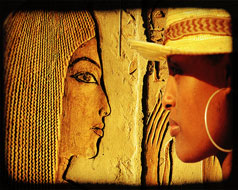
Ancient Egyptians looked like Ethiopic people
lfred Rosenberg, chief Nazi Party ideologue, could confidently claim Egypt’s ruling class for Europe’s peoples – and their Aryan branch at that. By the 1960s, however, the “Hamitic Hypothesis” had fallen from grace as the established orthodoxy. The linguist Joseph Greenberg demonstrated that the “Hamitic” languages were a chimera; no such unified group could be found. The people called “Hamites” were found to belong to differing language families. As the linguistic foundations for the hypothesis fell away, so too did the idea of a conquering “Hamitic Race.” W. E. B. Du Bois was right when he said: “We cannot if we are sane, divide the world into whites, yellows, and Blacks, and then call Blacks white.” He might have said that it would be equally as strange to call them “Mediterranean,” “Hamitic,” or a hundred other euphemisms. “Black” in the North American context. The “social “construction of race in America does not rely on skin color. “African Americans,” as Asante notes, ” constitute the most heterogeneous group in the United States biologically, but perhaps one of the most homogeneous socially.
Using a mountain of linguistic, pictorial, geographical and genetic evidence, these scientists established that the linguistic similarities between the Egyptian language and that of the Wolof (Senegalese) marked the Egyptian tongue as an indigenous African language: analysis of pigmentation, blood groups and hair have shown conclusively that the Egyptians were related to other Nile Valley Africans more so than any other type outside of the African continent.
Ancient artistic depictions again give much cause for reflection. Illustrations of red skinned men often reflected ceremonial colours rather than actual flesh tone. As seen in the painting of Nubians adorned with the same colours but never casting doubt upon the racial makeup of the people themselves.
RACE IN ANTIQUITY
See Race in Antiquity and African Race
EUROCENTRIC REVISIONIST
Some of us are taken in by the new “Eurocentric” lies. When Nat Geo released the Black Pharaohs some of us went crazy with joy screaming FINALLY they are telling the TRUTH. No! They are just telling better lies. First things
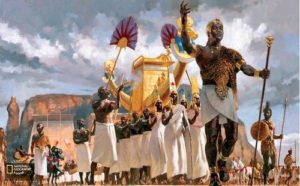
Painted by European revisionist
and we been telling you but not everyone gets it, there are no BLACK Pharaohs or BLACK anything in Africa. They are only African people! (aka you and me). So when Nat Geo is telling you about some Black Pharaohs you have to ask, So what color are the other ones? Exactly. Ancient Egypt is an African civilization full stop. Maybe as time progressed it became less homologous as Hyksos, Persian, Romans, Greeks and later Arabs settled. but it is at heart an African civilizations. This black thing is another lie to remove Ancient Egypt from Africa.and ask yourself have you ever heard of white kings of Greece ?
And the person doing the cover art for National Geographic is probably a white person drew the cover art. Because people in that region do not look like that and they d

Ancient Egypts by their own art
o they wear those clothes– That maybe Southern Africa or something. So it is a game. The ppl of Upper Egypt (lower for us today) and what is now Sudan looked like Ethiopians, they were the same African people. Just like Ethiopians and Somali are the same — yet different. And sameness is not so subjective that we can say “Oh no one knows what race the Ancient Egyptians are”, because we know they were not Aryan, or Chinese, do the discussion of Egyptian race is confined between dark skinned races/groups.
The Kingdom of Aksum
See Kebra Negast
By 350, Aksum or Axum conquered the Kingdom of Kush. At its height, Aksum controlled northern Ethiopia, Eritrea, northern Sudan, southern Egypt, Djibouti, Western Yemen, and southern Saudi Arabia, totaling 1.25 million square kilometers.
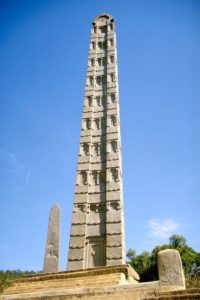
The Stele of Axum
The Aksum or Aksum empire was the 3rd largest African empire at 1.25 million sq km. In the sixth century, the kingdom of Aksum (Axum ) was doing what many elsewhere had been doing: pursuing trade and empire. Despite the disintegration of the Roman Empire in the 400s and the decline in world trade, Aksum’s trade increased during that century. Its exports of ivory, glass crystal, brass and copper items, and perhaps slaves, among other things, had brought prosperity to the kingdom. Some people had become wealthy and cosmopolitan. Aksum’s port city on the Red Sea, Adulis , bustled with activity. Its agriculture and cattle breeding flourished, and Aksum extended its rule to Nubia , across the Red Sea to Yemen , and it had extended its rule to the northern Ethiopian Highlands and along the coast to Cape Guardafui .
From Aksum’s beginnings in the third century, Christianity there had spread. But at the peak of Christianity’s success, Aksum began its decline. In the late 600s, Aksum’s trade was diminished by the clash between Constantinople and the Sassanid Empire. The Sassanid Empire clashed with Constantinople over trade on the Red Sea and expanded into Yemen, driving Aksum out of Arabia. Then Islam united Arabia and began expanding. In the 700s, Muslims occupied the Dahlak Islands just off the coast of Adulis, which had been ruled by Aksum. The Muslims moved into the port city of Adulis, and Aksum’s trade by sea ended.
Aksum was now cut off from much of the world. Greek- the language of trade – declined there. Minted coins became rare. And it has been surmised that the productivity of soil in the area was being diminished by over-exploitation and the cutting down of trees. Taking advantage of Aksum’s weakness, the Bedja people, who had been living just north of Aksum, moved in. The people of Aksum, in turn, migrated into the Ethiopian Highlands, where they overran small farmers and settled at Amhara , among other nearby places. And with this migration a new Ethiopian civilization began.
West Africa
In West Africa, trade was giving rise to towns. There, on the fringes of the Sahara, arose a kingdom and empire that its rulers called Wagadu. The people of this kingdom were the Soninke – African people who spoke the language of Mande. Their king was called Ghana, and Ghana became the name by which this kingdom and empire became known – ancient Ghana rather than the modern state also called Ghana.
It can be said with fair certainty that the Ghana-Melle Empire of the 14th century was far stronger, far richer, far better organized and even more literate than any Christian power in Europe — Goodwin, A.J.H
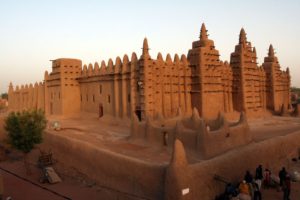
Djeanna Mosque in Mali
The kings of ancient Ghana were authoritarian. They inherited rule through their mother’s side of the family – matrilineal rather than patrilineal as with kings in Europe at the time – and they claimed descent from an original ancestor whom they believed had first settled the land. Ghana’s king was the leader of a religious cult that was served by devoted priests, and the king’s subjects were obliged to view him as divine and as too exalted to communicate directly with them.
Ghana’s kings had enhanced their power and enriched themselves by exploiting the trade passing through their territory. From the perspective of merchants they were not unlike highway bandits, forcing from tradesmen a tax on the gold they carried. But the tax was shrewder than robbery. Continuing robbery at will would have ended the arrival of gold on their territory.
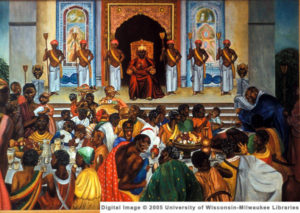
Medieval African Empires
As Ghana’s kings grew richer they conquered, forcing obedience from the kings of other tribes, from whom they exacted tribute. They extended their rule to the gold producing regions to their south, and they imposed a tax on gold production. Ghana’s major competitor was the Berber dominated city of Awdaghost to the northwest – a city with an ample supply of water, surrounded by herds of cattle and where millet, wheat, grapes, dates and figs were grown. The Berbers who dominated that city had wanted to make it the major point of passage for caravan trading across the western Sahara. But in 990 Ghana conquered the city, putting Ghana at the peak of its power.
D’mt
Dʿmt ( Ge’ez: ዳሞት, Dmt) was a kingdom located in southern Eritrea and northern Ethiopia that existed during the 10th to 5th centuries BC. Few Proto-Ge’ez inscriptions by or about this kingdom survive and very little archaeological work has taken place. As a result, it is not known whether Dʿmt ended as a civilization before Aksum’s early stages, evolved into the Aksumite state, or was one of the smaller states united in the Aksumite kingdom possibly around the beginning of the 1st century.
The most recent research, however, shows that Ge’ez, the ancient Semitic language spoken in Eritrea and northern Ethiopia in ancient times, is not derived from Sabaean. There is evidence of a Semitic-speaking presence in Eritrea and northern Ethiopia at least as early as 2000 BC.(Nadia Durrani, 2005). It is now believed that Sabaean influence was minor, limited to a few localities, and disappeared after a few decades or a century, perhaps representing a trading or military colony in some sort of symbiosis or military alliance with the civilization of Dʿmt or some other proto-Aksumite state.
NUBIA
Despite the new wave of myths regarding Nubia and Kemet (Ancient Egypt) It is clear that Kemet and Nubia were neighboring African Civilizations just as Aksum and Nubia. Difference doesn’t mean Nubia was a ‘black race’ and Kemet wasn’t.
Both groups were ethnic groups of indigenous African origin. The ethnic differences were no more significant than Ethiopians verses Kenyans. Ancient Nubia, like modern Sudan, was a land of many different peoples who identified themselves primarily by ethnic group and probably spoke many different languages. We now refer to them all as “Nubians” but they were not all the same, nor were they unified.
 The oversimplified concept of race (“black” and “white”) is challenged along the Nile Valley, for nowhere is there a clear transition from one to the other. In America some people use these terms passionately to identify their own cultural or ethnic allegiances within our own society. In the first half of the twentieth century, most European and American scholars identified the Egyptians as “white” and primarily “Near Eastern” in order to remove them from the African cultural sphere and to serve their ignorant and bigoted views that high civilization could only have been created by non-Africans. In the latter twentieth century, Afrocentric scholars indignantly challenged this model, asserting the “blackness” and “African-ness” of the Egyptians. In each case the aim of these scholars was to claim “ownership” of the Egyptians for their own “race” within the context of the modern, primarily American racial debate.
The oversimplified concept of race (“black” and “white”) is challenged along the Nile Valley, for nowhere is there a clear transition from one to the other. In America some people use these terms passionately to identify their own cultural or ethnic allegiances within our own society. In the first half of the twentieth century, most European and American scholars identified the Egyptians as “white” and primarily “Near Eastern” in order to remove them from the African cultural sphere and to serve their ignorant and bigoted views that high civilization could only have been created by non-Africans. In the latter twentieth century, Afrocentric scholars indignantly challenged this model, asserting the “blackness” and “African-ness” of the Egyptians. In each case the aim of these scholars was to claim “ownership” of the Egyptians for their own “race” within the context of the modern, primarily American racial debate.
In fact, the Egyptians are certainly Africans, but they are neither “white” in the European sense nor “black” in the Congo-African sense. It can be argued that they were like the modern Ethiopians or Somali people with straight to curly hair and narrow bone structure. So from a modern racial context they would sit in the African world just as Ethiopians, Sudanese, Fulani and Somalis do today. The Egyptians really possessed a wide range of skin color and many differing physical characteristics, as did the ancient Nubians. But as time progressed an Egypt mixed more with outsiders with the final influx of modern Arabs the racial texture of Egypt became more complex with a higher percentage of “white skinned Arabs.” (As seen in lower Egypt today (North Egypt).
The land of Nubia was located in what is now Sudan and lower Egypt. Home to what is considered to be the earliest African culture, Nubia waves of Central African inhabitants managed to transform a land notorious for its high temperatures and infrequent rainfall into a series of kingdoms that influenced, occasionally conquered and inevitably outlasted their more famous Egyptian neighbours. Nubian achievements include the worlds first Archaeoastronomy devices, conceived approximately a millennium before Stonehenge.
Below are excerpts from various historical and archeological sources that describe the progression of the Nubians from the initial organization of the settlers to the end of Christian domination around 1400AD. The reader is encouraged to follow the embedded links to find more information.
A-Group
A-Group is the designation for a distinct culture that arose between the First and Second Cataracts of the Nile in Nubia between the Egyptian 1st dynasty and the 3rd millennium BC. The A-Group settled on very poor land with scarce natural resources, yet they became the first Nubians to develop agriculture. This culture was one of the two important “kingdoms” in Lower Nubia. Artifacts from this culture were discovered in 1907 by Egyptologist George A. Reisner.
A-Group royal tombs were found to be two centuries older than those of the Egyptians. It is believed that the Egyptians developed their grave site customs for honoring pharaohs from Central Africa. The A-Group had strong beliefs in the afterlife. A great deal of time was put into their cemeteries and funerals.
C-Group
The so-called C-Group appeared in Lower Nubia about 400 years later and persisted from about 2500 to 1500BC. They likely like their cultural origins in Upper Nubia, and many of the artifacts that they left are quite different from those of their A-Group predecessors in the area. The C-Groupers traded with the Egyptians, but the Egyptians themselves wanted to exert more control over their southern neighbours. During the Middle Kingdon, they built forts near the second cataract of the Nile. During Dynasty 13, Egypt lost control of Nubia, and Nubians occupied the Egyptian formts. And toward the end of Dynasty 17, the rulers of Nubia and Hyksos rulers were treating each other as equals.
Kerma Culture
The Kerma culture, called Kush or Kushite by the Egyptians, was the first Nubian state, situated between the fourth and fifth cataracts of the Nile River in what is now the Sudan, between 2500 and 1500 BC. Early Kerma society was agricultural in nature and had round hut dwellings with distinctive circular tombs; later Kerma developed into a foreign trade-based society with mud-brick architecture, dealing in ivory, diorate, and gold.
Known as the “Land of the Yam†to the Egyptians, Kerma lay in a well-watered basin where Ethiopian nutrients deposited by the Nile supported the agricultural resources of the kingdom. They were rich in cattle for domestic use, sacrifice, and exported large numbers to Egypt. Prosperous and powerful, the kings of Kerma built a sprawling city with a white temple (deffufa) fortified by mud-brick walls and rectangular towers astride the ancient routes of trade from south to north and east to west. Their craftsmen produced exquisite black-topped pottery. The indigenous burials of their kings pre-date any Egyptian influence and were accompanied by ritual human and animal sacrifice. One Kerma royal turmulus records the slaughter of 4,00 cattle for the deceased.
At one point, Kerma came very close to conquering Egypt, with Egypt suffering a “humiliating defeat” by the hands of the Kushites. According to [the] head of the joint British Museum and Egyptian archaeological team, the attack was so devastating that, had the Kerma forces chosen to stay and occupy Egypt, they might have eliminated it for good and brought the great nation to extinction.
Egyptian Domination
Egypt dominated parts of Nubia from about 1950 to 1000 BC. Forts, trading posts and Egyptian style temples were built in Kush, and the Nubian elite adopted the worship of Egyptian gods and even the Egyptian hieroglyphic writing system. The gold, ebony and ivory of Nubia contributed to the material wealth of Egypt, and many of the famed treasures of the Egyptian kings were made of products from Nubia.
The one factor that chiefly characterized Egypt’s relationship with Nubia through most of their history was exploitation. Nubia’s most important resource for Egypt was precious metal, including gold and electrum.
Nubia was also an important source of manpower and labor for the Egyptians. The Palermo Stone records that early in the 4th Dynasty, King Snefru led a military campaign into Nubia reputedly to crush a “revolt” there (the Egyptians considered all enemies, whether foreign or domestic, as “rebels” against the natural order). According to that text, he captured 200,000 head of cattle and 7,000 prisoners, all of whom were deported to Egypt as laborers on royal building projects.
Napatan, Meroitic and Ballana Periods
The Napatan Period (about 700 – 300 BC) is named after the town Napata, where an Amun temple was built and where the kings were buried in small pyramids (the cemeteries are located not far at Nuri and el Kurru). Napata was the religious centre of the country. In the visible record Napatan culture seems heavily influenced by the Egyptians. The kings were buried in small pyramids, with an Egyptian style funerary equipment (shabtis, sarcophagi with religious texts, canopic jars, funerary stelae). The Egyptian hieroglyphic script was used. The exact order of most kings of the Napatan period is still under discussion. There is a group of well attested rulers dating shortly after the the end of Napatan control of Egypt (for example: Senkamanisken and Aspelta). Some kings dating to about the 4th century BC are again well-known from long monumental inscriptions (Arikamaninote, Harsiotef).
By 200 BC the capital had shifted yet farther south to Meroe, where the kings continued to be buried in pyramid tombs and to build temples to Nubian and Egyptian gods in a hybrid Egyptian Roman-African style. Roman historians record the skirmishes and treaties which marked the relation ship of Roman Egypt and Nubia. By AD 250 the culture of Nubia changed radically, perhaps due to the immigration of new peoples into the Nile Valley. Pyramid tombs were replaced by the great tumulus burials of the kings of Ballana.
Christian Period
Nubian Christianity developed in great isolation. Between 639 and 641, the Arabs conquered Egypt, and, from then on, Coptic Christians there were a diminishing minority in a country under Muslim rule. Despite this isolation, Nubian Christianity was to survive and, indeed, flourish for centuries.
Culturally, its Christianity was greatly influenced by Byzantium. The Nubians used the liturgy of St. Mark, and decorated the walls of their churches with murals that showed their royals dressed in Byzantine style. In 1961, Polish archaeologists excavated what appeared to be a mound of sand, and, within it, found Faras Cathedral, its walls decorated with 169 magnificent paintings of dark-skinned Nubian kings, queens and bishops, and biblical figures and saints.
The decline of Christianity in Nubia seems to have been mainly cased by a gradual process of Muslim immigration. As time went on, the Nubian population became increasingly dominated by Islam or Islamic Nubians. In 1315, the Muslim government of Egypt imposed a Nubian Muslim as the king of Makouria, and, in 1317, Dongola Cathedral officially became a mosque. However, the tiny Christian splinter kingdom of Dotawo survived in lower Nubia until the late 15th century.
TA-SETI
3,800 – 3,100 BC
In the darkness of mans waking moments on earth a mallet strikes an anvil and for the briefest of moments and while the universe holds its breath – the darkness is dispelled. The power of God ignites the plains of the Earth with brilliant civilizations. The first of such events manifested in the regions of modern day Egypt and was known as Ta-Seti, thus called ‘The Land of the Bow’ for its renown archers.
Nestled in the ancient land of Nubia known as ‘The Land of Gold’ – this civilization was established 300 years before the first dynasty of ancient Egypt was even a dream, as 12 noble dynasties reigned over its impressive countenance. In fact evidence suggests that it may have held the antecedence of Egypt in its womb signaling it as the first form of government and kingship known to mankind.
The idea of a pharaoh (king) may have come down the Nile from Nubia to Egypt (and) that would make Nubian civilization the ancestor of Egypt…
Dr. Bruce Williams, Archaeologist
These wonderful discoveries were made by archaeologists laboring tirelessly with spades, chisels and shovels, who have revealed the illustrious days of Ta-Seti – stradling the regions of northern Sudan and southern Egypt. Also known as Ethiopia and Kush, its hidden secrets were laid bare by Professor Bruce William’s in 1962. It took a colossal 20 years to gather the results of his teams extensive excavation.
Recognized for its fabulous natural resources of gold, ebony, ivory and incense – Ta-Seti engaged constantly with its neighbors in trade and commerce. Artefacts of profound importance discovered in the ancient ruins and royal tombs bear witness to craftsmanship of excelled skill and precision. Pottery and jewelry, found in Qustul, made to the highest order were encrusted with gold and precious stones: amethyst – carnelian.
Astonishingly, writing was found in abundance adorning exquisite pottery establishing the universal literacy for all who lived in this forgotten but pivotal realm. This hieroglyphic textual evidence constitutes the oldest known form of writing yet discovered!
The Kingdom of Ghana
In west Africa, in what is modern day Mali and southern Mauritania, a golden age was coming into fruition. Ancient Ghana ranks as one of the most noteworthy of African Kingdoms, as Dr Basil Davidson as stated;
Important archaeological discoveries late in the 1970’s have revealed a more complex and much earlier development, well before Ancient Ghana of 300 AD, of early state-like communities and even early cities. Surveys and excavations in this ‘Middle Niger’ region completed in 1984 at no fewer than forty-three sites of ancient settlement, proved that they belonged to an Iron Age culture developing there since about 250 BC, that the settlements grew into urban centers of natural size and duration’.
The city Dr Davidson alludes to is the city of old Djenne and its neighboring lands. Large stone masonry villages have also been discovered dating as far back as 1100 BC. Their archaeological finds include roads and walls of 2 metres high very likely erect in defense of the village.
Taking the title ‘Ghana’ meaning King, figures through out history expanded upon these beginnings and the Ghanaian Empire began in earnest in 300 AD.
The Sonninkes, the founders of the empire, who excelled in the use and manufacture of iron had the advantage of superior weapons, quickly dominated surrounding nations.
At its heart was Kumbi-Salah which acted as a hive of extensive trade and attracted caravans from a variety of regions. Famed for its gold from the Wangara region, commented upon by the Arab writer Ibn Fazari who called Ghana the land of gold, compered it in size to its northern contemporary Morocco, while salt came to the city from the Sahara. Due to their expertise with iron and other metals, ancient Ghana traded in some of the finest artefacts in the area. Along side cotton, it was also known for its leather work called ‘Moroccan Leather’ despite the fact that it indeed originated in Ghana.
Ibn Khaldun the well known Arab historian of the 14th century had this to say concerning the Ghanaian empire.
At the time of the conquest of Northern Africa by the Arabs (between the periods 639 and 708 CE), some merchants penetrated into the western regions of the blacks and found among them no king more powerful than the King of Ghana. His states extended westwards to the shores of the Atlantic Ocean. Ghana (Kumbi-Salah) the capital of this strong, populated cities of the world…
More wonders came from these African lands as attested too by another Arab geographer Ibn Haukal who commented in amazement on the lucrative trade that flourished in the region. His comments made in 951 CE mentions a check produced for the sum of 42,900 golden dinars written for a merchant in the state of Audoghast from a partner in Sidjilmassa in the north! Tales abound of one particular gold nugget weighing 30 pounds! This was truly a land of astonishing wonders and lavished wealth. A far cry from the misconception of the African languishing in barbarity and ignorance!
Ibn Khaldun again makes mention of the lifestyle of the ancient Ghanaians while quoting from a book written in 1067 by Abu Ubaid Al-Bakri. He describes the Muslim quarter which had sprung up to facilitate the trans-Saharan trade with north Africa, containing 12 mosques, buildings of stone and acacia wood, schools and centres of education. It was described further as ‘the resort of the learned, of the rich and pious of all nations’.
A truly cosmopolitan city where the finest silk and brocade were worn by the populace.
In 990 CE Audoghast to the north was captured and included into the sprawling Ghanaian Empire. It was a fine addition and boasted a dense population including many from as far away as Spain. Its streets were lined with elegant houses, public buildings and mosques. The surroundings were rich in pastoral lands including sheep and cattle, making meat plentiful. Wheat was found in the market places in abundance imported from the north, honey from the south and a variety of foodstuffs from other regions. Robes of blue and red from Morocco was a popular fashion at the time. All which exchanged hands with payments of gold dust, cowrie shells or salt.
The ruler at the time emperor Tenkamenins court was described in the following terms by Al-Bakri;
When he gives and audience to his people he sits in a pavilion around which stand his horses caparisoned in cloth and gold; behind him stand 10 pages holding shields and gold-mounted swords and on his right hand are the sons of the princes of his empire, splendidly clad and with gold plaited into their hair. The governor of the city is seated on the ground in front of the King, and all around him are his ministers in the same position. The gate of the chamber is guarded by dogs of an excellent breed, who never leave the kings seat, they wear collars of gold and silver.’
However, according to popular legend, in 1079 the land was invaded from the north by Almoravids pouring out of the newly founded Moroccan city of Marrakesh. A mass exodus ensued by the people of Ghana who fled southwards to escape the conflict. New research conclusively proves the Almoravid destruction Ghana never happened, it was a legend (boast) of the Almoravids which crept into history [Masonen, Pekka; Fisher, Humphrey J.]
By 1087 the Soninkes were some how in control of the empire, and by this time most Ancient Ghanians were Muslim, but the empire disintegrated into several smaller states. Leadership was again assumed by native Ghanaian leaders but the days of glory were gone and the empire soon broke up.
Wagadou Empire (“Land of Herds”. existed c. 750-1200) The Kingdom of Ghana is generally given the dates 9th to the 13th century CE by historians. It marks the beginning of a series of empires in West Africa that were involved in extensive commercial trade. The introduction of the camel, which preceded Muslims and Islam by several centuries, brought about a gradual revolution in trade, and for the first time, the extensive gold, ivory, and salt resources of the region could be sent north and east to population centers in North Africa, the West Asia (Middle East) and Europe in exchange for manufactured goods. This all proves trade in this region was ancient. You should note by looking at the map above that the area of the Kingdom of Ghana during this time period is farther north than the present day country of Ghana, which Kwame Nkrumah names after Ancient Ghana.
Some have called the Kingdom of Ghana the “land of gold, ” an excellent description since it was abounding in gold. The gold trade was largely responsible for the development of Ghana into a powerful, centralized kingdom. The peoples of West Africa had independently developed their own gold mining techniques and began trading with people of other regions of Africa and later Europe as well. At the time of the Kingdom of Ghana, gold was traded for salt that came down from the Sahara desert.
In addition to the gold trade, historians have pointed to a second important factor in the development of these West African Kingdoms. This was the use of iron. The use of iron to make tools and weapons helped some people to expand their control over neighboring people. These changes called for new forms of social organization, contributing to the development of centralized, powerful empires. Historians also say that the use of the horse and camel, along with iron, were important factors in how rulers were able to incorporate small farmers and herders into their empires.
Rulers of Awkar
- King Kaya Maja : circa 350 AD
- 21 Kings, names unknown: circa 350 AD- 622 AD
- 21 Kings, names unknown: circa 622 AD- 750 AD
Soninke Rulers “Ghanas” of Wagadou Empire
- Majan Dyabe Cisse: circa 750s
- More GhanasRuler, names unknown: circa 750s- 1040
- Bassi: 1040- 1062
- Tunka Manin: 1062- 1076
Almoravid Occupation
- General Abu-Bakr Ibn-Umar: 1076- 1087
Ghanas of Wagadou Kingdom
- Kambine Diaresso: 1087- 1090s
- Suleiman: 1090s- 1100s
- Bannu Bubu: 1100s- 1120s
- Majan Wagadou: 1120s- 1130s
- Musa: 1140s- 1160s
Rulers during Kaniaga Occupation
- Diara Kante: 1180-1202
- Soumaba Cisse as vassal of Soumaoro: 1203-1235
Ghanas of Wagadou Tributary
- Soumaba Cisse as ally of Sundjata Keita: 1235-1240
The Ghanaian kings controlled the gold that was mined in their kingdom and implemented a system of taxation for their people. Around 1054, the Almoravid rulers came south to conquer the Kingdom of Ghana and convert the people to Islam. The authority of the king eventually diminished, which opened the way for the Kingdom of Mali to begin to gain power. The trade that had begun, however, continued to prosper.
Two important sources that have told historians about the history of the Kingdom of Ghana are the writings of a Spanish Muslim named Al-Bakri and archaeological finds. Archaeologists have worked at excavating a site that many believe to be one of the king’s cities of the Kingdom of Ghana, Kumbi Saleh.
Kanem-Bornu Empire
The Sahel region of the Sudan, that is the region immediately south of the Sahara desert in central and western Africa, saw four of the greatest African empires. The largest and longest lasting was Ghana, followed by Mali and its successor, Songhay. Near central Africa, however, arose another great empire called Kanem around 1200
Kanem was originally a confederation of African groups, but by 1100, a group of called the Kanuri settle in Kanem and in the thirteenth century the Kanuri began to conquer the surrounding areas. They were led by one of the great figures of African history, Mai Dunama Dibbalemi (1221-1259), who was the first of the Kanuri to convert to Islam. Dibbalemi declared jihad, or “holy war,” against surrounding chieftaincies and so precipitated one of the most dynamic periods of conquest in Africa. At the height of their empire, the Kanuri controlled territory from Libya to Lake Chad to Hausaland. These were strategic areas: all the commercial traffic through North Africa had to pass through Kanuri territory. As a result of the military and commercial growth of Kanem, the Kanuri slowly changed from a nomadic to a sedentary people. In the late 1300’s, civil strife within Kanuri territory began to seriously weaken the empire so that by the early 1400’s, Kanuri power shifted from Kanem to Bornu, a Kanuri kingdom south and west of Lake Chad. When Songhay fell, this new Kanuri empire of Bornu grew very rapidly. The Kanuri grew powerful enough to unite the kingdom of Bornu with Kanem during the reign of Idris Alawma (1575-1610). Idris Alawma was a fervent Muslim and set about building a Muslim state all the way west into Hausaland in northern Nigeria. This state would last for another two hundred years, but in 1846, it finally succumbed to the growing power of the Hausa states.

